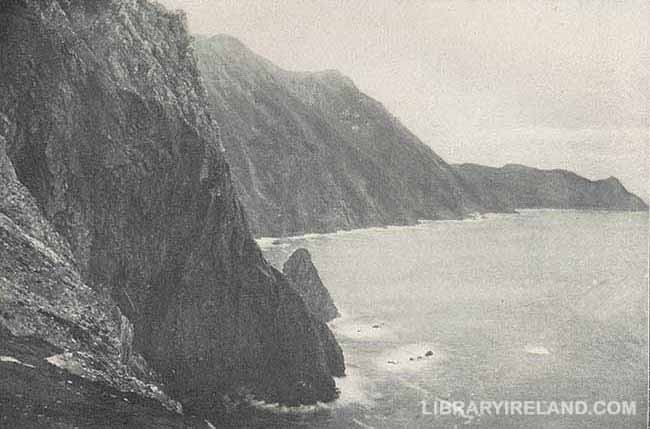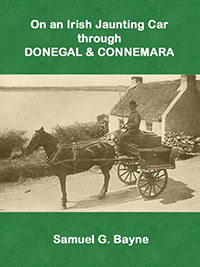Achill Head
When we awoke we crawled on all-fours to the edge of the head and looked over, and we shall never forget the sight that greeted our eyes! Achill Head and Croaghaun Mountain, adjoining it, have the reputation of being the highest marine cliffs in existence. They are poised above the Atlantic at an angle of sixty degrees, and the particular point on which we lay far overhung the ocean. Here lightning-splintered pinnacles shoot from the mass; savage, titanic rocks lie on the face of the two mountains in wild confusion, scarred and rent from top to bottom, and the blue waters surge and break at their base in restless confusion, throwing up the spray to great heights. Then for a moment all is calm, only to begin over again. It was as if the grandest Alpine scenery had the Atlantic breaking on its lower levels, and yet it retained the charm of the finest verdure. Between the crevices grew blooming heather, luxuriant ferns, wild flowers, and arbutus in great profusion, while flocks of wild gulls circled gracefully through the air in quest of food, the whole being enveloped in the warm, moist air of the Gulf Stream, rising from the face of the ocean and suffusing the cliff upon which we rested, giving it practically the temperature of a hot-house. It was always a struggle between the mist and the sun; each alternately gained the mastery, and it was this weird kaleidoscope that held us spellbound and presented wonderland in a new guise.

Achill Head, County Mayo
The Croaghaun Mountain, two thousand two hundred and nineteen feet in height, lay right beside us, joined to Achill Head by a rocky bridge. Its grand and peculiar feature is that at the very highest point it would seem as if the rest of the mountain had been suddenly cut away, leaving a vast and tremendous precipice descending to the water nearly one thousand nine hundred and fifty feet. Deep fissures and rocky furrows have been worn by the torrents which pour down after heavy rains, and the bottom, where it shelves slightly, is strewn with bowlders and masses of shattered rock, forming natural bulwarks against the advancing tide. From where we stood, the view seaward was, of course, boundless, the nearest land being America. It is doubtful if such another panorama is unfolded from any other height in the British Isles. Far out is the Black Rock, on which is a light-house two hundred and sixty-eight feet high, and to the northward are North and South Inishkea and Duvillaun.
The Mullet peninsula, Erris, and the ever-varying outlines of Blacksod Bay lie spread out like a map, and beyond Slievemore is a network of island and inlet, above which the splendid range of the Ballycroy Hills forms a background. In the distance is Nephin; far to the south rises the rugged head of Croagh Patrick and the mountains round Clew Bay; farther off are the summits of the Twelve Pins; Achill Beg lies immediately below; beyond it, Clare Island, and farther south Inishturk, Inishbofin, and Inishshark bound the horizon. Off the Mullet are numerous islands, of which the principal are Inishkeeragh and Inishglora, where, according to some, the dead are subject to such extraordinary and preserving influences that their nails and hair grow as in life, "so that their descendants to the tenth generation can come and with pious care pare the one and clip the other." The eagle still haunts these cliffs, and the wild goat feeds almost secure in his last haunts on these islands.
It was growing late, and, as we had five miles of walking before us, we retraced our steps down the mountain to Keem Bay. The trials of that descent have not been written in sand—they will never be forgotten. In our exhausted condition we reeled and staggered from hummock to hummock, floundered through the soggy bog like a pair of stranded seals, sat down in the heather for a few gasps of breath when we could go on no longer. We guyed each other, guyed the Emerald Isle and its people; we sneered at the story of George's hatchet, and concluded that, after all, King Edward's job was not what it was cracked up to be—anything to divert our minds from the dreadful present.
If we could have put Achill Island and all its scenery out of commission forever, we would gladly have done it. But time and the hour run through the roughest day, and so we got to the bottom. At the beach we saw a cowherd coming towards us with numerous cans, and, supposing these to be full, we pounced upon him for a drink of milk. Luck was against us again—his cans were empty, and he told us he had to walk a mile or more to where his cows were grazing before he could fill them. We braced ourselves for the final walk round the mountain, and as it was a fair road we had little difficulty in reaching the shed where we had left the car in the early morning. The driver was watching for us, and we gladly swung ourselves up on the seats; and no pair of Irish kings ever enjoyed riding in royal state more than we did. We stopped a few minutes at a lake by the wayside to see some of the hotel guests catching a basket of fine trout, which were afterwards served for a late supper.
We awoke next morning stiff and sore, but a breezy chat with our genial host soon put us on good terms with ourselves and everything about us. We left Achill Island in the afternoon, deeply regretting that we had not more time to devote to its wonders.
Read "On an Irish Jaunting Car through Donegal and Connemara" at your leisure
Read On an Irish jaunting Car through Donegal and Connemara at your leisure and help support this free Irish library.
Samuel Gamble Bayne was born in Ramelton, County Donegal, and educated at Queen's University in Belfast. At the age of twenty-five he left for America with a view to making his fortune. He invested in an oil well in Pennsylvania and later founded a bank which subsequently came to be the JP Morgan Chase bank in New York. By the time this book was written he was wealthy enough to be referred to as a billionaire. His account of the tour through the north, west and south of Ireland is a pleasant snapshot of how that part of the country was in the early part of the 20th century. He describes what is to be seen, gives some background history and, through the illustrations especially, provides wonderful glimpses of the area's social history.
The ebook is available in .mobi, .epub, and .pdf formats. See details ».

